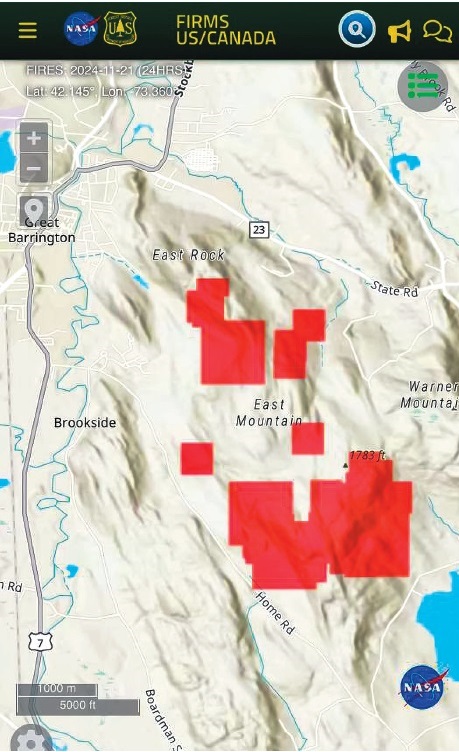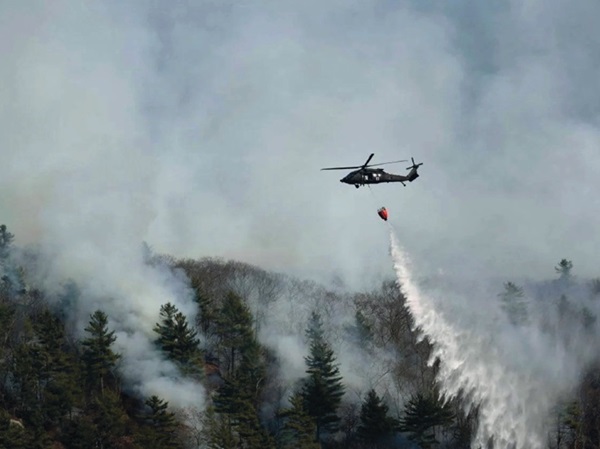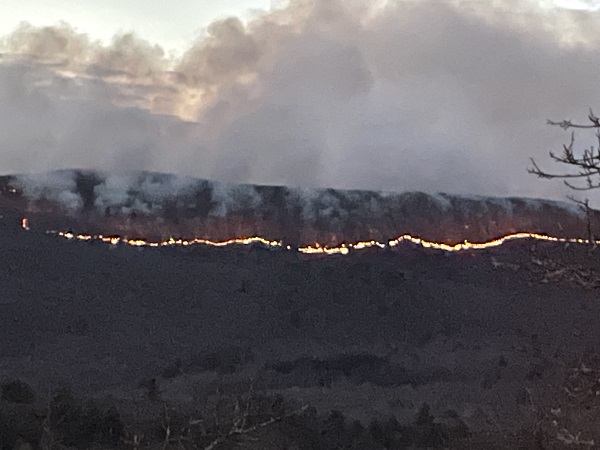| The Sandisfield Times |
|---|
| Drought: Summer and Fall |
|
By Tom Christopher |
|
"Schizophrenic" is the best description of the last six months of weather in Sandisfield. We started the summer with record heat and above average rainfall, creating a tropical microclimate that had this writer battling all sorts of fungal infections in his vegetable garden. Then Nature turned off the tap. September was bone dry, and October drier. During the latter month, there was almost no measurable precipitation and the temperatures remained unseasonably high, breaking records on Halloween and climbing into the 80s on October's last day. This abnormal heat promoted evaporation of what little moisture was in the soil, drying up streams, and drastically lowering river flows. One notable response to this aridity was an upsurge in wildfires, with more than 400 flaring up across Massachusetts in October. As of this writing, Sandisfield has been spared but a rapidly expanding forest fire in Great Barrington that spilled over the border into Sheffield before being contained. There's a temptation to regard the weather flipflop we've experienced this summer and fall as a freak, an aberration. In the past, it would have been just that. However, climate scientists have been predicting just this pattern for quite a while. In 2014, for example a national climate assessment derived from observations and research by 15 Federal agencies including the Department of Agriculture, the Department of Defense, the Department of the Interior, and the National Science Foundation predicted that as temperatures continue to rise (a trend that was already apparent in weather records for our region dating back to the founding of the National Weather Service in 1870) our region would experience an increase in average annual precipitation, but that this would come in fewer, more violent events concentrated in the early and late parts of the year. Hotter summers would result in greater evaporation and droughts lasting through the fall.
The last update of the national climate assessment published in 2018 reported symptoms of climate change that any attentive resident of our region had already noticed. Shorter, warmer winters for example, have become obvious to Sandisfield motorists who cannot fail to have noticed that these have changed the timing and severity of the "mud season" that historically afflicted our dirt roads in early spring. Maple syrup makers have had to cope with less predictability in the onset and duration of the tree tapping season. The fall foliage season, whose formerly glorious colors were a mainstay of the tourist industry, has become less reliable, frequently aborted by drought. Neighbors have reported the drying up of residential wells this past fall that had previously provided a reliable flow. Such symptoms are concerning, but the emerging threat of forest fires is of a different caliber. This makes the need for action obvious and impossible to ignore any longer. We will need a societal response in a continued move away from consumption of fossil fuels. But there is also much that an individual can do, and in this region famed for ingenuity, that could have a big impact. One way to attack climate change that draws on this reporter's experience as a horticulturist is to make changes in our personal landscapes. A reduction in the use of synthetic fertilizers for lawns, gardens, and farmers' fields can provide a significant benefit. The largest component of such products are typically nitrates which are produced by a process that uses natural gas as both a feedstock and a fuel; to produce one ton of fertilizer nitrates requires the consumption of 33 thousand cubic feet of natural gas. And once spread on the garden, turf, or agricultural field, synthetic nitrates begin escaping into the atmosphere as "laughing gas," nitrous oxide, which is 300 times as potent as carbon dioxide as a greenhouse gas. Converting your lawn to less nitrogen hungry turf grasses such as fine fescues (which are also more drought resistant than the traditional Kentucky bluegrass and require far less frequent mowing) can be an important personal contribution to this crisis. Getting your garden soil tested so that you avoid unnecessary fertilization is not only a way to save money but also to reduce your personal contribution to climate change. Farmers, and gardeners, too, can add fertility to the soil without the use of fertilizers by planting cover crops during the off-season. Homeowners can sow clover into their lawns - clover not only has the ability to convert nitrogen from the atmosphere into a natural source of nutrients for the grass, it will also make your lawn more supportive of pollinating insects such as our embattled wild bees.

The boxes show where the fire spread across East Mountain behind the Great Barrington Fairgrounds, and south into Sheffield. It was finally brought under control, thanks to great effort by firefighters and, ultimately, rain and snow that arrived just in time. Landscaping with native, locally indigenous plants, which as a group tend to be more drought-tolerant than traditional, nursery-bred garden plants, will help to keep your surroundings green and less flammable during dry spells. They will also do a far better job of feeding the local wildlife which is one of Sandisfield's great attractions. I am sure that foresters, farmers, and landscape maintenance professionals, as well as ingenious local residents (Sandisfield is not short of them) can all add ideas for reducing our community's contribution to climate change. Our region has a long history of taking the initiative when confronted with challenges. This particular challenge has too often been presented as solely a matter of doing without. I believe that it can also provide stimulus for a move to a healthier and more satisfying relationship to nature, to biologically richer and more beautiful human landscapes, and ultimately a more resilient, less disaster-prone local environment. The difficulties of the last six months may have been just the wake-up call we all needed. |

|
Home Page
© The Sandisfield Times.
All rights reserved.Published December 1, 2024

